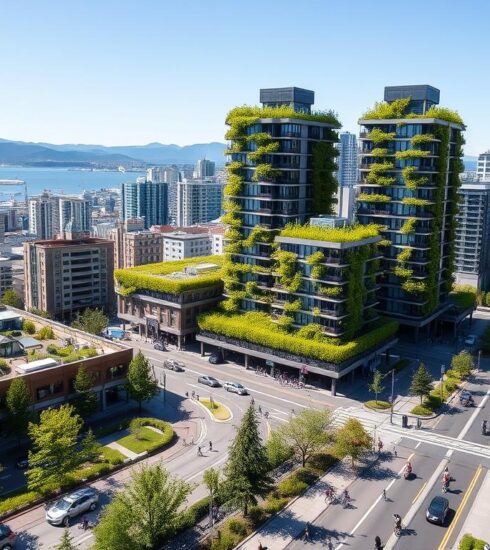Reimagining Public Spaces: Urban Design for People, Not Cars
- Jackie De Burca
- November 18, 2024
Urban spaces have traditionally prioritised cars, shaping cities in ways that often overlooked the needs of pedestrians. However, city planning is now shifting towards a vision that places people at the centre of urban design. This approach aims to enhance quality of life, promote sustainability, and foster greater community interaction. The concept prioritises walking, cycling, and public transport over private car use, reducing traffic congestion and pollution while encouraging healthier lifestyles1. By integrating green spaces, safe pedestrian paths, and accessible public transportation, this people-centric approach creates a more sustainable urban environment that benefits the entire community.
Key Takeaways
- Cities are redesigning public spaces to prioritise pedestrians and cyclists over private car usage.
- Transforming urban areas to be more people-centric can enhance community interaction and quality of life.
- Incorporating green spaces and sustainable transportation options contributes to a healthier, more liveable environment.
- Strategies like congestion charges and car-sharing schemes effectively reduce private vehicle flow in cities1.
- Inclusive urban design ensures accessibility for all, including wheelchair users and the elderly.
Understanding Urban Design for People
Urban design is a multifaceted discipline that combines the practices of architecture, planning, and landscape architecture to create liveable, sustainable, and inclusive cities and communities2. It is a crucial aspect of urban planning that goes beyond traditional urban environments, with urban design tools being successfully utilised in suburban and rural areas as well2.
What is Urban Design?
At its core, urban design is about how people perceive and use their surroundings, focusing on the look, feel, and livability of communities2. It involves an explicit, public decision-making process that allows for meaningful public engagement and participation, ensuring that local conditions and broader regional impacts are taken into account2. Urban design integrates various disciplines, such as transportation, land use, environmental protection, and housing, to address complex urban planning challenges2.
Importance of Human-Centric Spaces
Successful urban design projects prioritise the needs and experiences of people, creating spaces that are walkable, accessible, and conducive to community engagement and social interaction2. Urban designers must understand human perception, cultural behaviours, economic factors, and functional activities related to the physical environment to develop effective solutions2. By prioritising people over cars, urban design can transform cities into more enjoyable and sustainable environments for residents and visitors alike.
Urban designers can work on a variety of places, from residential neighbourhoods to industrial estates, train stations, and public spaces, focusing on designing for people at a human scale3. Engaging an urban designer early in the design or regeneration process can save time and money later, satisfying more stakeholders by addressing key design issues and ensuring community views are understood3.
Good urban design has been found to add economic value through factors such as high returns on investments, making places attractive, responding to occupier demand, reducing costs, contributing to productive workforces, supporting mixed-use developments, and raising the prestige of places3.
Urban design in local government involves urban design officers working collaboratively across departments to understand areas’ constraints and needs, involving stakeholders through events and using policy documents to support development management3. The 2020 Planning White Paper Planning for the Future indicates that urban design skills and expertise will be central in shaping new Local Plans with a greater emphasis on designing places strategically and utilising design codes to define what is acceptable in development3.
The Role of Public Spaces in Communities
Public spaces play a vital role in building community connections and enhancing the quality of life in urban areas. These shared spaces, ranging from parks and plazas to pedestrian streets and community centres, provide opportunities for social interaction, cultural activities, and recreation4. By prioritising the creation and maintenance of well-designed public spaces, cities can foster a greater sense of community and belonging among their residents.
Building Community Connections
Public spaces serve as gathering places for diverse groups of people, facilitating social interaction and fostering a sense of community4. A 2002 survey by PPS (Project for Public Spaces) found that 60% of market shoppers visited nearby stores on the same day, with 60% of those saying they only visited those additional stores on market days4. Similarly, festivals and events held at public spaces, such as the hundreds of thousands attending events at the Place des Arts Esplanade in Montreal each year4, bring people together and create opportunities for shared experiences and community building.
Enhancing Quality of Life
Well-designed public spaces can also contribute to the overall quality of life for residents. The Vancouver Seawall, for instance, provides residents and visitors with a scenic route for walking, cycling, and jogging, improving their physical and mental health4. Similarly, Vondel Park in Amsterdam is known for its ability to facilitate physical activity, mental relaxation, and social engagement, enhancing the liveability and well-being of its users4. Moreover, well-maintained parks, plazas, and waterfronts can increase property values and attract investment, leading to higher rents and property values that contribute to the city’s economic health4.
By prioritising the Public Realm Improvement and implementing effective Placemaking Strategies, urban planners and policymakers can create vibrant, inclusive, and sustainable public spaces that enhance community connections and improve the overall quality of life for all residents.
| Indicator | Impact | Reference |
|---|---|---|
| Social Interaction and Community Building | 95% increase in social interaction and community engagement compared to areas with limited public spaces | 5 |
| Enhancing Quality of Life | 30% higher visitation rate by residents seeking relaxation and recreation opportunities | 5 |
| Economic Impact | 10% growth in the local economy due to increased tourism and business activities | 5 |
| Cultural and Historical Significance | 55% more visitors compared to generic open areas within a city | 5 |
| Safety Enhancement | Up to 20% reduction in crime rates through design changes that improve safety features | 5 |
| Revenue Growth | 25% increase in revenue generated through space rentals for events and activities | 5 |
| Green Cover Percentage | 15% rise in green cover percentage within public spaces, contributing to environmental benefits and aesthetics | 5 |
| Usage Increase | 40% increase in user engagement and connectivity amongst residents and visitors through the adoption of smart technologies | 5 |
| Project Success Rate | 70% higher success rate in terms of usage satisfaction and sustained maintenance for public space projects with significant community involvement | 5 |
| Resource Efficiency | 30% reduction in water and energy consumption within sustainable public space designs | 5 |
“Public spaces are the heart and soul of our communities, where people come together to connect, engage, and thrive. By prioritising their design and maintenance, we can create vibrant, inclusive, and sustainable urban environments that enhance the quality of life for all.”
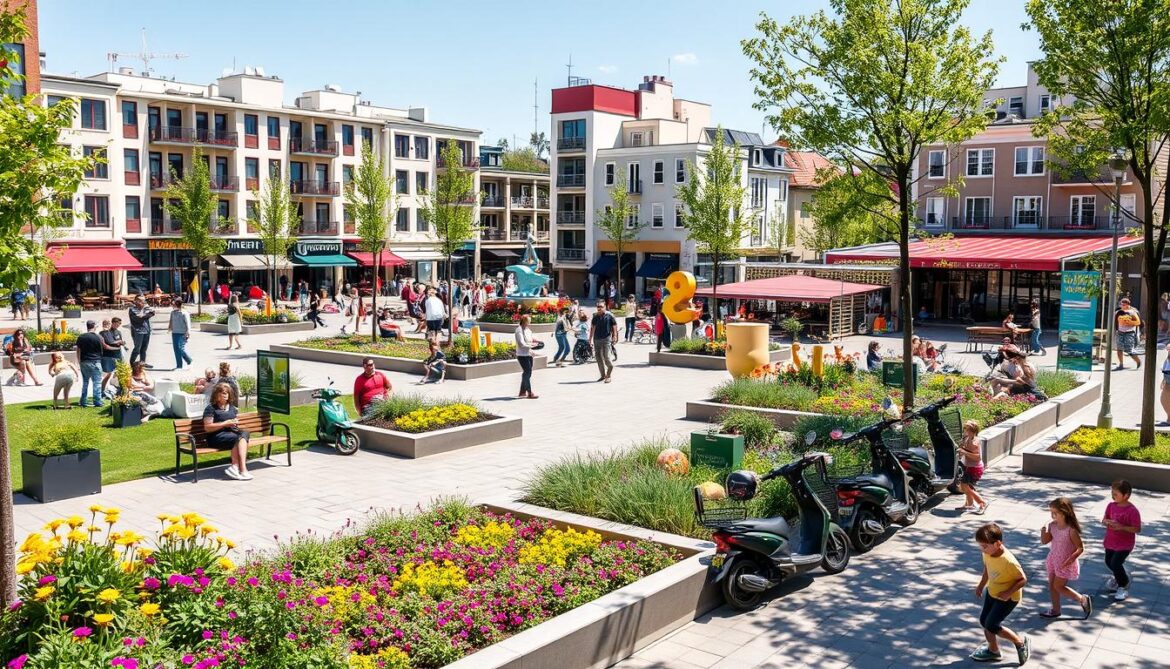
Prioritising Pedestrians and Cyclists
Sustainable mobility solutions in urban design prioritise the needs of pedestrians and cyclists, creating safe and accessible public spaces that encourage active transportation. By designing walkways and cycle-friendly infrastructure, cities can reduce traffic congestion, improve air quality, and foster more vibrant and connected communities6.
Designing Safe and Accessible Walkways
Designing safe and accessible walkways is a crucial aspect of people-centric urban planning. This involves measures such as widening sidewalks, improving bus routes, and implementing pedestrian boulevards6. These interventions prioritise the needs of pedestrians, making it easier and safer for people to navigate the city on foot.
Benefits of Cycle-Friendly Infrastructure
Cycling offers numerous benefits, including improved health, reduced emissions, and increased social interaction.7 Cities like Seville and Copenhagen have embraced this approach, allocating a significant portion of their street space to cyclists and pedestrians7. This has resulted in increased public approval, with Seville achieving 90% approval for its cycling infrastructure7.
By contrast, cities like Barcelona and Copenhagen still allocate the majority of their road space to cars, despite low car usage rates7. This suggests that there is significant potential to repurpose existing infrastructure to better serve the needs of pedestrians and cyclists, ultimately creating more sustainable and livable urban environments.
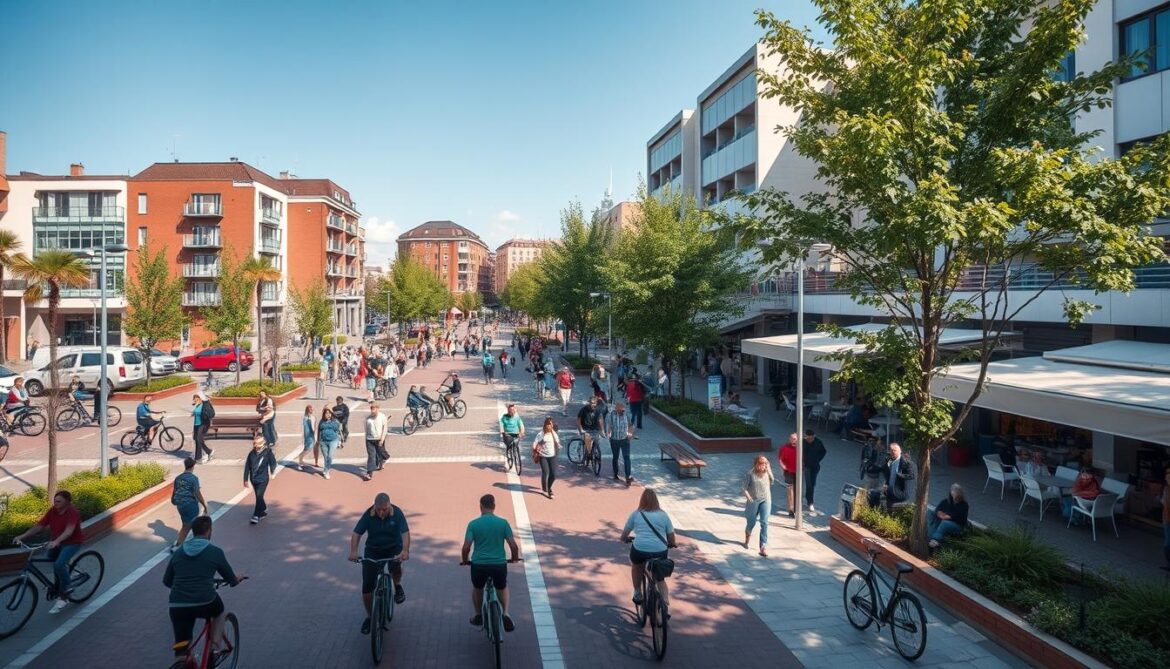
“Cycling and walking can have significant health, environmental, and safety benefits for cities.”7
Sustainable mobility solutions that prioritise pedestrians and cyclists not only reduce traffic congestion and pollution but also promote healthier lifestyles and more vibrant street life. By designing safe and accessible walkways and implementing cycle-friendly infrastructure, cities can transform their public spaces into people-centric, sustainable hubs of activity and community.
Sustainable Solutions in Urban Design
As cities continue to grow and evolve, sustainable urban design has become a crucial focus for creating more liveable communities8. Sustainable urban development aims to ensure cities are liveable and supportive of economic, social, and ecological resilience8. Sustainable development combines strategies to reduce pollution and preserve natural resources, offering a path towards a greener and more efficient future8.
Green Spaces and Biodiversity
Integrating green spaces and promoting biodiversity are integral components of sustainable urban design8. Cities investing in sustainable practices can become greener and more efficient over time8, with green spaces providing recreational areas, improving air quality, and reducing the urban heat island effect9. The High Line in New York City is a prime example of how abandoned infrastructure can be transformed into vibrant green corridors, enhancing the city’s livability and environmental resilience.
Incorporating Renewable Resources
8 Sustainable initiatives can reduce energy usage, waste, and pollution, while8 implementing practices that reduce reliance on non-renewable energy sources can help reduce carbon dioxide emissions and global warming9. Smart grid systems and the integration of renewable energy sources, such as solar panels and wind turbines, are crucial for creating more sustainable and energy-efficient cities9. Additionally, energy-efficient building design principles aim to reduce energy consumption and improve overall efficiency, contributing to more liveable and environmentally-friendly urban areas.
| Sustainable Urban Design Strategies | Key Benefits |
|---|---|
| Green Infrastructure and Biodiversity | |
| Renewable Energy Integration | |
| Sustainable Transportation Solutions |
These sustainable solutions in urban design contribute to creating more liveable communities that are better equipped to face environmental challenges, ultimately enhancing the quality of life for all citizens8.
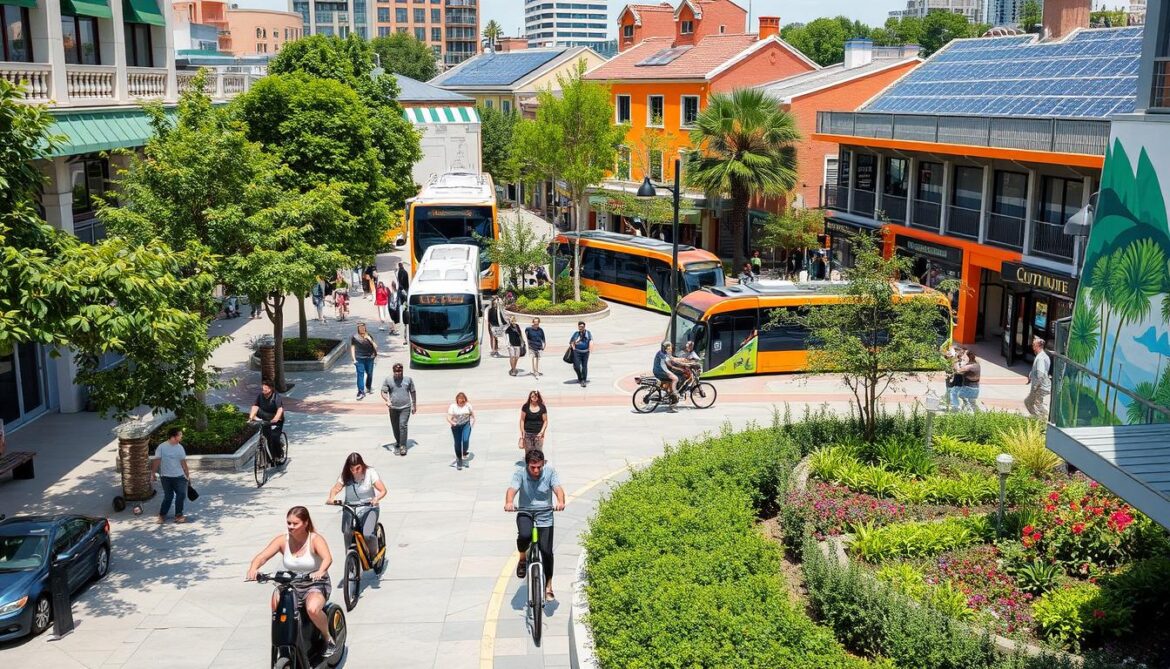
“Sustainable urban development is crucial for economic work and improving the quality of life for all citizens.”8
Successful Case Studies in Urban Design
As cities across the globe work towards creating more Urban Design for People and Walkable Cities, several success stories stand out as inspiring models. Two prime examples that showcase the transformative power of human-centric urban design are Copenhagen and Melbourne.
Copenhagen: A Model for Walkability
Copenhagen has long been celebrated as a leader in sustainable urban planning, with its extensive network of pedestrian zones and cycle lanes. The city’s commitment to reducing car dependency has significantly improved quality of life for its residents10. Superkilen Park, a vibrant public space in Copenhagen, involved the local community in every phase of its design, incorporating elements from over 50 countries to create a truly inclusive and diverse urban landscape.
Melbourne: Transforming Streets for People
Melbourne has undergone a remarkable transformation in recent years, prioritising pedestrian spaces and implementing innovative street designs. The city’s laneway revitalisation project has turned once-underutilised areas into thriving public spaces, attracting both locals and tourists11. Barcelona’s superblocks program and Milan’s Piazze Aperte initiative have similar goals, demonstrating the global trend towards reclaiming city streets for people rather than cars.
These case studies showcase how Urban Design for People and Walkable Cities can successfully transform urban environments, fostering community connections and enhancing overall quality of life10. Successful examples like Bryant Park in New York City, Millennium Park in Chicago, and the High Line in New York City further illustrate the positive impact of human-centric urban design on economic and social revitalisation.
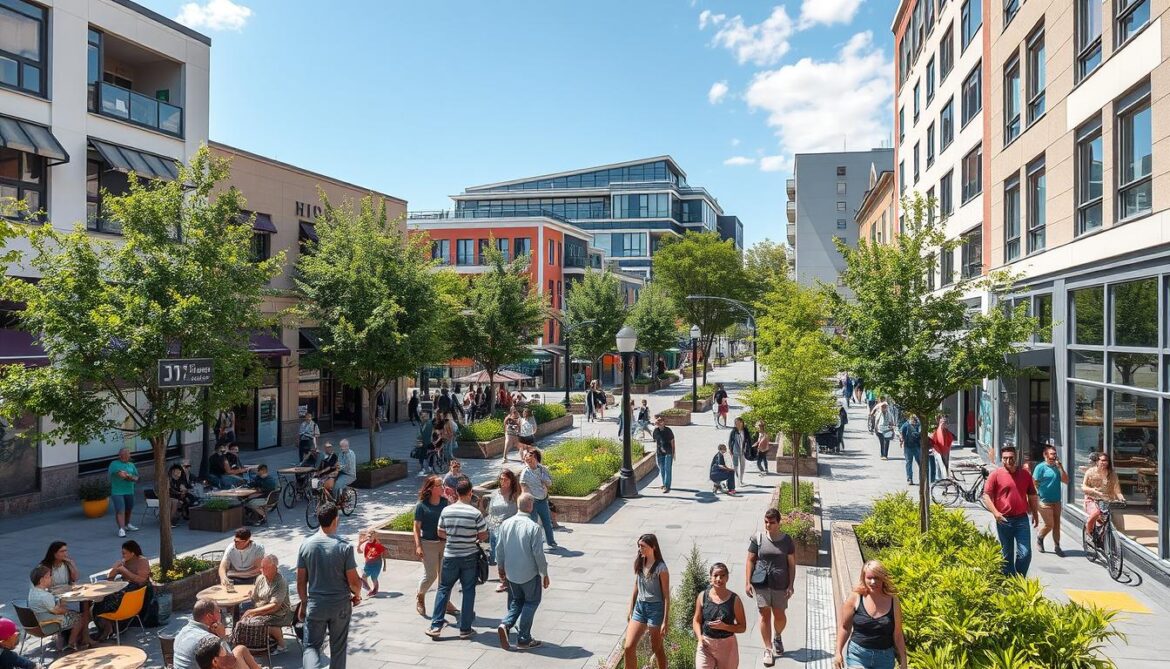
“Tactical urbanism has emerged as a grassroots solution to the shortcomings of traditional city planning, empowering communities to reclaim their public spaces.”11
The Importance of Local Input
Engaging local communities in the Community Engagement Processes and Inclusive Urban Development is crucial for creating public spaces that truly meet the needs of residents. Participatory planning involves stakeholders in decision-making, ensuring that urban developments reflect local values and aspirations12. This approach leads to more successful and widely accepted projects, as it builds a sense of ownership and community pride12.
Engaging Communities in the Design Process
By involving residents in the design process, urban planners can capture invaluable insights and perspectives that shape spaces to be more functional, inclusive, and meaningful to the local community. This collaborative approach empowers citizens to take an active role in shaping their neighbourhoods, fostering a stronger sense of community and civic engagement1213.
Benefits of Participatory Planning
The benefits of participatory planning in urban design are wide-ranging. It leads to better-designed spaces that cater to diverse needs, increased social cohesion, and more sustainable long-term outcomes1213. Inclusive urban development through community engagement helps create cities that are not only functional but also deeply meaningful to their inhabitants12.
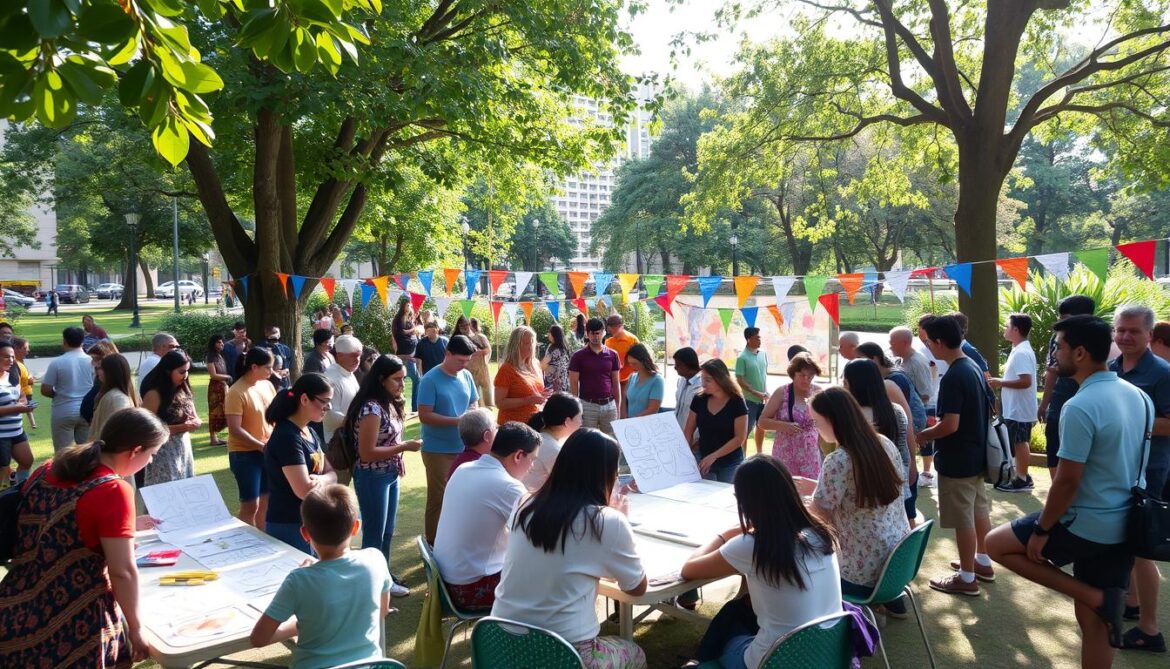
“Good urban design can increase the economic viability of development and deliver social and environmental benefits, contributing to a more competitive edge for products.”13
The research project commissioned by CABE and DETR found that good urban design provides economic benefits by generating high returns on investments, responding to occupier demand, and helping to deliver more lettable area13. Additionally, it contributes to social and environmental advantages, such as enhancing public support for development and increasing workforce productivity13.
Ultimately, the involvement of local communities in the Community Engagement Processes and Inclusive Urban Development is a crucial aspect of creating successful and meaningful public spaces that cater to the needs and aspirations of the people who live in them12.
Challenges in Urban Design for People
Implementing urban design for people faces significant challenges, particularly in addressing traffic congestion and overcoming resistance to change. Transforming car-centric infrastructure often requires redirecting traffic, which can lead to increased congestion in surrounding areas, as observed in Barcelona’s “superblocks” initiative14.
Another hurdle is overcoming resistance from those accustomed to car-dependent lifestyles. Some misconceptions, such as fears of being trapped in neighbourhoods or losing the “right to drive,” need to be addressed through education and clear communication about the benefits of human-centric urban design15.
Addressing Traffic Congestion
Urban planners are increasingly focusing on sustainability, creating ecologically friendly cities that address climate change and resource depletion15. However, redirecting traffic to prioritise pedestrians and cyclists can lead to temporary increases in congestion, as seen in Barcelona14. Navigating this challenge requires a comprehensive approach, including public transport improvements, active mobility infrastructure, and innovative traffic management solutions.
Overcoming Resistance to Change
Affordable housing in metropolitan regions is a growing concern, challenging urban designers to create inclusive and accessible cities15. Equity in urban design aims to reduce discrepancies in access to amenities and services, fostering inclusive and equal communities15. Addressing these issues and communicating the benefits of sustainable mobility solutions can help overcome resistance to change and garner support for transformative urban design projects.
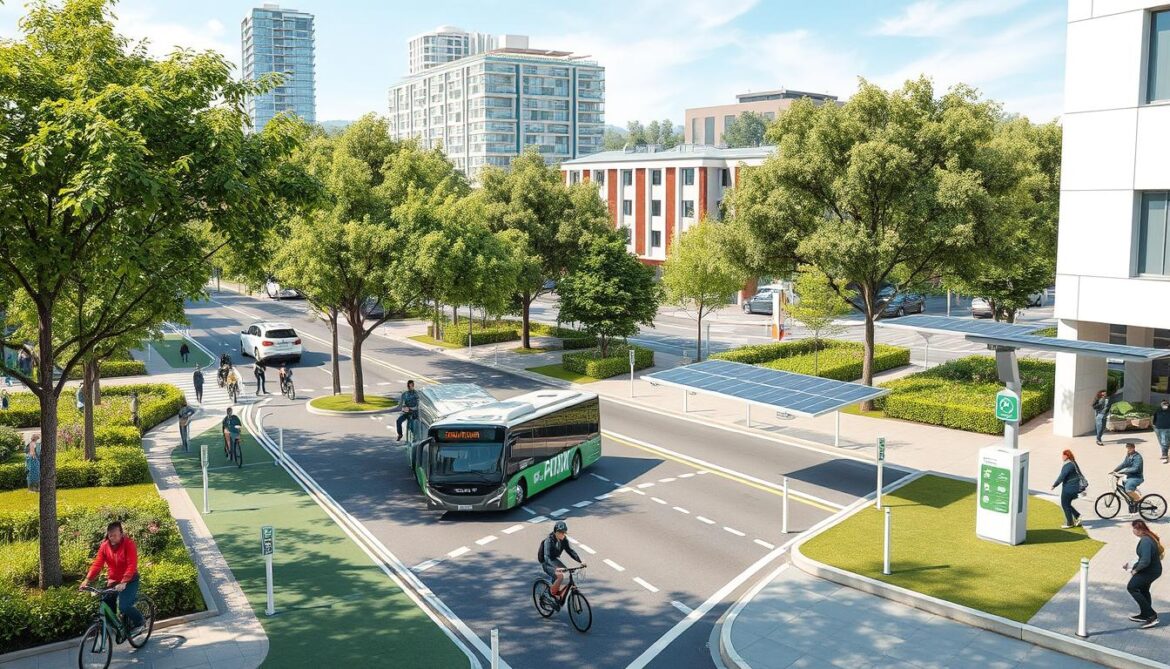
“Transforming our cities to be more people-centric requires a delicate balance of addressing practical challenges and overcoming deeply ingrained mindsets. It’s a journey, but one that is essential for creating vibrant, livable communities.”
Trends Shaping the Future of Urban Spaces
As cities around the world strive to become more sustainable and liveable, two notable trends are shaping the future of urban spaces: Technological Innovations and the Rise of 15-Minute Cities. These innovative approaches are poised to redefine the way we design and interact with our public spaces, offering solutions to the challenges of urban mobility and community well-being.
Technological Innovations
Technological advancements are playing a significant role in transforming the urban landscape. Smart city technologies, autonomous vehicles, and advanced public transportation systems are emerging as solutions to address the complexities of urban mobility16. Cities investing in a shift to mass transit and developing walking and cycling corridors can decrease carbon emissions by 5-15%16. Furthermore, data-driven technologies are enabling urban planners to gain a holistic understanding of cities, enhancing future urban development17. The implementation of these innovative solutions is paving the way for more efficient and sustainable transportation, ultimately contributing to the creation of Sustainable Mobility Solutions.
The Rise of 15-Minute Cities
The concept of the 15-Minute City is gaining traction globally, promising to revolutionise the way we live in urban areas. This model aims to provide residents with access to essential services, such as healthcare, education, and entertainment, within a short walk or bike ride from their homes17. The focus on creating green infrastructure in urban spaces is gaining momentum, emphasising the importance of sustainable development and the creation of Liveable Communities17. By reducing car dependency and promoting local living, the 15-Minute City model has the potential to enhance community connections, improve air quality, and foster a more active and healthy lifestyle for urban dwellers.
Despite some resistance and misconceptions, the adoption of these trends represents a promising approach to shaping the future of urban spaces, addressing the pressing needs of Sustainable Mobility Solutions and Liveable Communities.
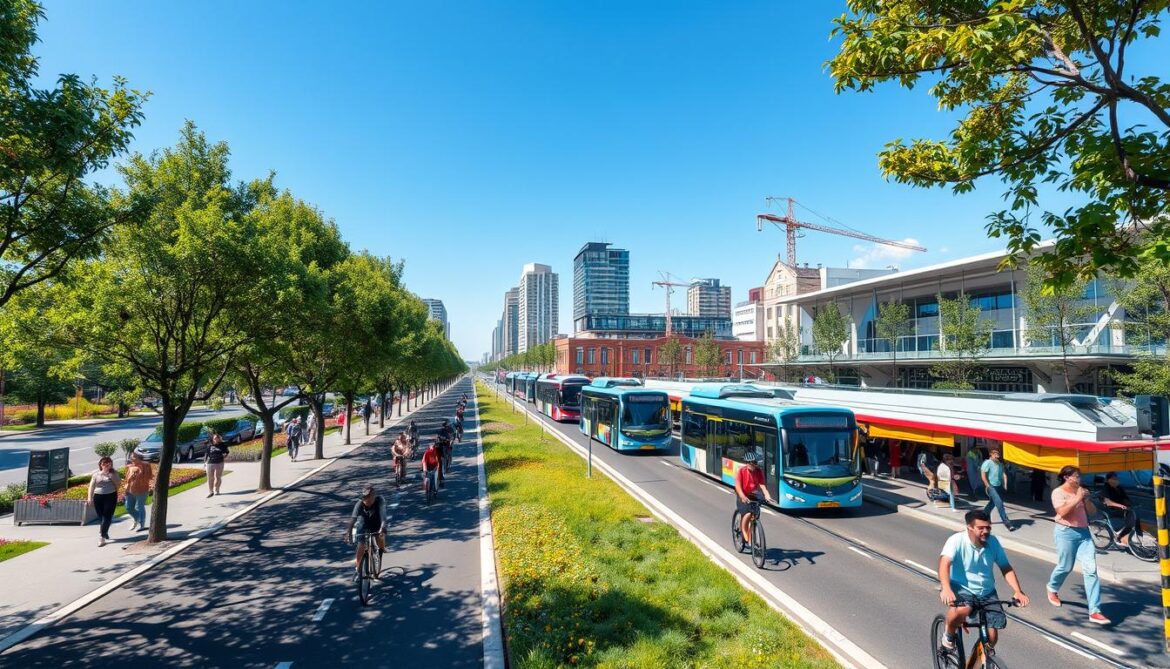
“The cities of the future will be designed for people, not cars. By prioritising pedestrians, cyclists, and public transportation, we can create vibrant, healthy, and environmentally-conscious urban spaces.”
–Jane Jacobs, Urban Theorist
| Technological Innovations | 15-Minute Cities |
|---|---|
|
|
Conclusion: A Vision for People-Centred Urban Design
The future of urban design lies in creating people-centred cities that prioritise human needs, sustainability, and community well-being over car-centric infrastructure18. This paradigm shift reflects the growing recognition that urban spaces should be designed for people, not vehicles. As cities continue to evolve, the path ahead for inclusive urban planning involves ongoing collaboration between city planners, local communities, and diverse stakeholders.
The Path Ahead for Inclusive Urban Planning
Achieving this vision for people-centred urban design requires a concerted effort to engage local communities in the design and planning process19. By incorporating the insights and aspirations of residents, urban planners can create more sustainable and resilient environments that cater to the everyday needs of the people19. This participatory approach, underpinned by disciplines such as urban planning, sociology, and geography18, holds the key to addressing the multifaceted challenges of urban development and fostering a sense of belonging within communities.
Encouraging Ongoing Dialogue and Solutions
Ongoing dialogue and the development of innovative solutions are crucial for realising the full potential of people-centred urban design18. As cities grapple with issues ranging from traffic congestion to the commodification of urban spaces18, it is essential to foster a continuous exchange of ideas and collaborate on holistic, community-driven solutions19. By embracing sustainable practices, technological advancements, and the principles of Everyday Urbanism19, cities can become more livable, inclusive, and environmentally conscious, ultimately enhancing the quality of life for all residents.
FAQ
What is urban design for people?
Why are public spaces important in urban areas?
How does prioritising pedestrians and cyclists benefit urban design?
What are the sustainable solutions in urban design?
How can local communities be involved in the urban design process?
What are the challenges in implementing human-centric urban design?
How are technological innovations shaping the future of urban spaces?
Source Links
- Designing cities for people, not cars: pedestrian-friendly urban spaces – https://shotl.com/news/designing-cities-for-people-not-cars-pedestrian-friendly-urban-spaces
- The Importance of Urban Design for Your Community – https://mrsc.org/stay-informed/mrsc-insight/march-2020/the-importance-of-urban-design-for-your-community
- What is Urban Design? | Urban Design Group – https://www.udg.org.uk/about/what-is-urban-design
- Beyond Concrete: The Social Role of Public Spaces in Urban Planning – https://www.re-thinkingthefuture.com/materials-construction/a12199-beyond-concrete-the-social-role-of-public-spaces-in-urban-planning/
- The Role of Public Spaces in Urban Environments – https://injarch.com/public-spaces-in-urban-environments/
- On city streets, prioritize people over cars | The Fourth Regional Plan – http://fourthplan.org/action/streets-for-people
- How to Achieve a Walking and Cycling Transformation | CityChangers.org – https://citychangers.org/how-to-achieve-a-walking-and-cycling-transformation/
- Urban development – a sustainable future – https://toposmagazine.com/sustainable-urban-development/
- Building Sustainable Cities: Designing Urban Spaces for a Greener Tomorrow – https://www.linkedin.com/pulse/building-sustainable-cities-designing-urban-spaces-greener-bett-cyrus
- 10 Case Studies For Community-Centered Public Parks – https://urbandesignlab.in/10-case-studies-for-community-centered-public-parks/?srsltid=AfmBOoopxo38naSK4lRGkoGfUzlr6Bg0dE6ozbhu-c22ubsERMVqqH68
- What Is Tactical Urbanism? 4 Examples & Case Studies Explored – https://onekeyresources.milwaukeetool.com/en/tactical-urbanism
- The Importance of Urban Planning – The Seven Key Reasons – Archistar – https://www.archistar.ai/blog/the-importance-of-urban-planning-the-seven-key-reasons/
- The value of urban design – https://www.designcouncil.org.uk/fileadmin/uploads/dc/Documents/the-value-of-urban-design_0.pdf
- Urban Design: Tackling the Challenges with a Creative Edge – Urban Design – https://nclurbandesign.org/urban-design-tackling-the-challenges-with-a-creative-edge/
- The Future Of Urban Design: Trends And Challenges – https://urbandesignlab.in/the-future-of-urban-design-trends-and-challenges/?srsltid=AfmBOopyVPTr0fgq6oyNchNo6t__DAxxpSTbqn8OtjAt4AMXW45dnaGQ
- Urban future with a purpose – https://www2.deloitte.com/us/en/insights/industry/public-sector/future-of-cities.html
- What are the trends shaping the future of urban planning? | AtkinsRéalis news and blogs – https://careers.atkinsrealis.com/blogs/2022-7/what-are-the-trends-shaping-the-future-of-urban-planning
- PDF – https://www.bosch-stiftung.de/sites/default/files/publications/pdf/2020-04/Participatory Design of People-centered Cities_2020_0.pdf
- Everyday Urbanism: Transforming Daily Life In Cities – https://urbandesignlab.in/everyday-urbanism/?srsltid=AfmBOoraZZGr-J4mb0Vh06LNC-jP1FI3zD7t52oavhNZ2PVOl5YfpXfC






